Collaborative teaching for relational rigor
Co-teaching or collaborative teaching or teaching with colleagues is a common practice in Finnish teacher education (e.g., Kokko et al, 2021; Kähkönen & Airo, 2019; Pesonen et al., 2020). The practice can take different forms (e.g., teaching and observing, teaching and assisting, parallel teaching, alternative teaching etc.). In all cases, co-teaching involves the combination of teachers’ abilities and skills in course planning, implementation and evaluation and learning together. There are different benefits listed in the relevant literature, including work in heterogeneous classes and setting up reciprocal environments (e.g., Kokko et al., 2021). Importantly, as Kähkönen & Airo (2019) argue, co-teaching contributes to the transformation of university teaching with the possibility for experimentation and community building that it offers.
In our article, where we discussed metaphors of mentoring for education without walls, we argued for the need to decolonize engagement with learning (Stein et al., 2022) through narratives of relational rigor. Relational rigor requires seeing education otherwise and this means opening up spaces of hope. We see spaces of hope as being tied with the process of collaboration and the need for a critical understanding of reality, given that we aim for sustainable systems and sustainable futures. In their study of collaborative teaching in school environments, Pesonen et al. (2020) found that the practice is linked with the sense of belonging of those involved in the co-teaching situation. The sense of belonging, therefore, depends on with the ways relations are built with colleagues, the leadership and the wider school and societal context.
In our situation, i.e., an international higher education development project where there are multiple educational, socio-political, historical and cultural divergences (Vivitsou et al., 2023), building the sense of belonging could mean a space of mutual understanding that would allow the trust needed to take joint pedagogical action. Co(-llaborative) teaching therefore leads to joint pedagogical action and needs both shared purposes (value system) and specific aims and objectives (informed practice). Based on these principles, members of OLIVE from the Faculty of Educational Sciences in the University of Helsinki and the Faculty of Education in Birzeit University, we developed together online modules, as part of the project aim to uncover pathways to mentoring. Creative situated writing is one of the modules for OLIVE project.
Creative situated writing: an example of collaborative teaching and hybrid sustainability learning
The module draws from situated writing theory and method (e.g., check M. Livholts’s work (2019): https://site-writing.co.uk/situated-writing-as-theory-and-method-2019/) to explore the complexities of life through creative and art-based methods, e.g., memory work, poetry, photography and storytelling, and the use of different media narratives and genres (e.g., blogposts etc.). For this purpose, the module aims to develop an understanding of writing as process (vs product) aiming for specific purposes (e.g., private writing vs writing for an audience; sharing views on social media; informed vs non-informed opinions, etc.). Also, module objectives are:
- Familiarizing with creative-situated writing principles and the need to teach creative writing; why creative writing should be situated?
- Writing Learning Journals/Diaries for a deeper understanding of the learning process; developing into independent thinkers and autonomous learners (reflect on personal experiences, find different ways of self-expression, memories to collect into a book or a novel etc.);
- Reading and understanding social media posts; conncting with real-life, sustainability-related problems;
- Practicing argumentative writing: using images to make a point; synthesize and analyze based on visual representations;
- Bring forward the students’ imaginaries of sustainable futures and steps to take toward this direction.
To meet these ends, the co-teaching process involved both contact and online sessions with undergraduate students at Birzeit University. For the contact session, the following resources were introduced and were further analyzed and developed from distance in both synchronous and asynchronous modes, combining blended and hybrid tasks (see below).
Lesson plan, contact session 20May2023
Basic teaching and learning activity plan
Main theme: Sustainability in education, teaching and learning
Aim: to introduce the notion of sustainability education; to reflect on a possible sustainability-related problem and come up with ideas about possible solutions
Warm-up questions
- What does sustainability mean to you? Examples of types of sustainability?
- What action is needed to promote sustainability in teacher education?
Introduction (check resources below for more)
- Photos of Greta from Instagram as intro to the theme of climate crisis and environmental sustainability
- Obstructor, as example of social sustainability with focus on bullying and harassment
Tasks
- Watch the video and think about sustainability issues that SM is talking about in her speech. Link to video: Sanna Marin’s speech at New York University, May 2023.
- Watch the video again and think about a sustainability issue that you would like to find solutions for.
- Write a letter/tweet/Instagram-post to Sanna Marin explaining the issue to her, what it is, why it is important and asking her about different ideas and ways of dealing with this issue.
- Think about the structure of the letter: In order to write a strong, well-supported letter to SM, what kind of information will you need?
Resources
Blogpost https://blogs.helsinki.fi/sveasusproject/?p=172
Sanna Marin’s speech in NYU, May 2023: https://www.hs.fi/politiikka/art-2000009591716.html
Greta Thunberg, Instagram account, @GretaThunberg


References
Kokko, M., Takala, M. & Pihlaja , P. (2021). ‘Finnish teachers´ views on co-teaching, British Journal of Special Education, vol. 48 , no. 1 , pp. 112-132 . https://doi.org/10.1111/1467-8578.12348
Kähkönen, E. & Airo, K. (2019). Collaborative teaching as a tool in university development. In Proceedings, 47th Annual Conference Complexity is the new normality, Budapest, Hungary, 16-20.09.2018.
Pesonen, H. V., Rytivaara, A., Palmu I.& Wallin, A. (2021). Teachers’ Stories on Sense of Belonging in Co-Teaching Relationship, Scandinavian Journal of Educational Research, 65:3, 425-436, DOI: 10.1080/00313831.2019.1705902
Stein, S.; Andreotti, S.; Ahenakew, C.; Suša, R.; Valley, W.; Amsler, S.; Cardoso, C.; Siwek, D.; Cajkova, T.; D’Emilia, D.; et al. (2022). Methodologies for gesturing towards decolonial futures. In Weaving an Otherwise: Reframing Qualitative Research through Relational Lenses; Tachine, A., Nicolazzo, Z., Eds.; Stylus Publishing: Sterling, VA, USA,
Vivitsou, M., Hamad, F. K., and Janhonen-Abruquah, H. (2023). A Metaphorical Analysis of Mentoring for Education without Walls in Palestine and Finland with the OLIVE International Project as a Key Example, Education Sciences 13, no. 3: 290. https://doi.org/10.3390/educsci13030290

